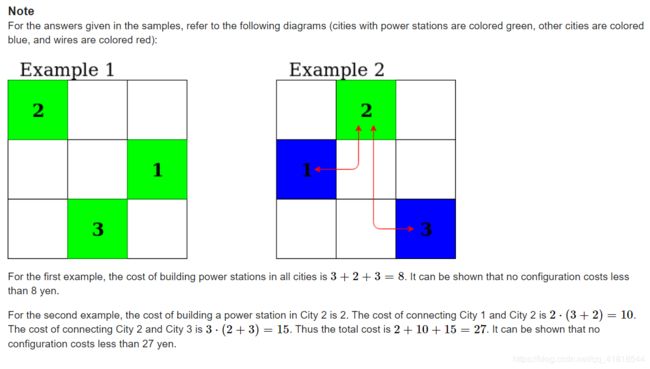- 21、子图同构问题的深度解析
metal
子图同构图论算法
子图同构问题的深度解析1.子图同构问题概述子图同构问题是图论中的一个核心问题,广泛应用于社交网络分析、生物信息学、模式识别等领域。该问题的定义是:给定两个图,一个是较大的主图(HostGraph),另一个是较小的模式图(PatternGraph),判断主图中是否存在一个子图与模式图同构。简单来说,就是要找到主图中与模式图结构完全一致的子图。子图同构问题的难度在于它是一个NP完全问题,意味着在最坏情
- Dijkstra算法求最短路径问题
Dijkstra算法求最短路径问题——HM图论中最常见的问题就应是最短路径问题了,解决这一问题的几个基本算法有三个:Floyed、Dijkstra和SPFA了。现在我来浅谈一下Dijkstra的思想与实现。单纯的Dijkstra并不是很快,算一个点到其余各点的时间复杂度是O(n^2)级别,算每个点到其余各点的复杂度就是O(n^3)了,在提高组竞赛中不占优势,但其进行优化后便很强大了,如用堆优化Di
- 算法:floyd和高精度 洛谷 最短路 P1037 [NOIP 2002 普及组] 产生数
健仙
算法算法数据结构c++
思路:因为某个数变成另一个数是单向的,并且一个数变成另一个数后还可以变,让我联想到图论的内容,一个数变成其他数就相当于这个数与另一个数有单向边,而且边之间的线路可以让一个数可能变成很多数,因为数据量很小,我就想到了floyd,就是我们用floyd做传递闭包,得出一个数可以变成哪些数,然后将每个位看一遍,乘起来就是答案,不过这里有个小坑,答案超过了2的64次方,所以还要高精度算法处理一下。代码:#i
- 算法竞赛备赛——【图论】求最短路径——Floyd算法
Aurora_wmroy
算法竞赛备赛算法图论c++蓝桥杯数据结构
floyd算法基于动态规划应用:求多源最短路时间复杂度:n^3dijkstra:不能解决负边权floyd:能解决负边权不能解决负边权回路问题求最短路径:dijkstrabfsfloyd思路1.让任意两点之间的距离变短:引入中转点k通过k来中转i---->k---->jj2.找状态:n个点都可以做中转点的情况下,i到j之间的最短路径的长度是x最终状态:dp[n][i][j]=x;中间状态:dp[k]
- Java机考题:815. 公交路线 图论BFS
吗喽对你问好
java图论宽度优先
给你一个数组routes,表示一系列公交线路,其中每个routes[i]表示一条公交线路,第i辆公交车将会在上面循环行驶。例如,路线routes[0]=[1,5,7]表示第0辆公交车会一直按序列1->5->7->1->5->7->1->...这样的车站路线行驶。现在从source车站出发(初始时不在公交车上),要前往target车站。期间仅可乘坐公交车。求出最少乘坐的公交车数量。如果不可能到达终点
- 图论篇--代码随想录算法训练营第五十九天打卡|Bellman_ford 算法精讲,SPFA算法,Bellman ford之判断负权回路,Bellman ford之单源有限最短路
無量空所
leetcode算法图论c++
本系列算法用来解决有负权边的情况Bellman_ford算法精讲题目链接:94.城市间货物运输I题目描述:某国为促进城市间经济交流,决定对货物运输提供补贴。共有n个编号为1到n的城市,通过道路网络连接,网络中的道路仅允许从某个城市单向通行到另一个城市,不能反向通行。网络中的道路都有各自的运输成本和政府补贴,道路的权值计算方式为:运输成本-政府补贴。权值为正表示扣除了政府补贴后运输货物仍需支付的费用
- LeetCode第317题_离建筑物最近的距离
@蓝莓果粒茶
算法leetcodelinux算法c#学习pythonc++
LeetCode第317题:离建筑物最近的距离文章摘要本文详细解析LeetCode第317题"离建筑物最近的距离",这是一道图论和广度优先搜索的问题。文章提供了基于多源BFS的解法,包含C#、Python、C++三种语言实现,配有详细的算法分析和性能对比。适合想要提升图论算法能力的程序员。核心知识点:广度优先搜索、图论、矩阵遍历难度等级:困难推荐人群:具有图论基础,想要提升算法能力的程序员题目描述
- Swift 图论实战:DFS 算法解锁 LeetCode 323 连通分量个数
网罗开发
Swift算法swift图论
文章目录摘要描述示例题解答案DFS遍历每个连通区域Union-Find(并查集)题解代码分析(Swift实现:DFS)题解代码详解构建邻接表DFS深度优先搜索遍历所有节点示例测试及结果示例1示例2示例3时间复杂度分析空间复杂度分析总结摘要图是算法中最具挑战性的结构之一,而“连通分量”这个词听起来也有点像社交网络里的“圈子”概念。给你一张无向图,节点编号从0到n-1,现在请你找出这个图中到底有多少个
- C++最小生成树算法详解
你的冰西瓜
c++算法图论最小生成树
C++最小生成树算法详解引言在图论中,最小生成树(MinimumSpanningTree,MST)是一个非常重要的概念。对于给定的带权无向连通图,最小生成树是一棵包含图中所有顶点且边权之和最小的树。它在网络设计、电路布线等实际应用中具有广泛的意义。本文将详细介绍两种常见的最小生成树算法:Prim算法和Kruskal算法,并提供C++实现代码。一、最小生成树的基本概念1.1生成树一个连通图的生成树是
- 算法学习笔记:10.Prim 算法——从原理到实战,涵盖 LeetCode 与考研 408 例题
呆呆企鹅仔
算法学习算法学习笔记JavaPrim
在图论的世界里,最小生成树(MinimumSpanningTree,MST)是一个至关重要的概念,它在通信网络设计、电路布线、交通规划等领域有着广泛的应用。求解最小生成树的算法中,Prim算法以其独特的“逐步扩展”思想占据着重要地位。Prim算法的基本概念在正式介绍Prim算法之前,我们先回顾一下最小生成树的定义:对于一个具有n个顶点的带权连通图,其最小生成树是包含所有n个顶点的一棵无环子图,且该
- GNN--知识图谱(逐步贯通基础到项目实践)
峙峙峙
图神经网络知识图谱人工智能
原文仓库链接:知识图谱–贯通已有知识地图记录知识关系图谱和跨学科碰撞新启发知识图谱mermaid可能需要下载插件才能渲染线性代数神经网络深度学习框架硬件加速图论GNN框架交叉理解前向理解定义:前向理解:A–>B,A为B的基础铺垫知识,通过深入学习A对B有更好的理解01.LinearAlgebraforLinearLayerofNN从线性代数行列变换的角度看神经网络中的线性层线性代数矩阵乘法,可以理
- 算法分析与设计实验2:实现克鲁斯卡尔算法和prim算法
表白墙上别挂我
算法笔记经验分享
实验原理(一)克鲁斯卡尔算法:一种用于求解最小生成树问题的贪心算法,该算法的基本思想是按照边的权重从小到大排序,然后依次选择边,并加入生成树中,同时确保不会形成环路,直到生成树包含图中所有的顶点为止。具体步骤:边的排序:将所有边按照权重从小到大排序。初始化:创建一个空的生成树(可以是一个空的图结构),以及一个用于记录每个顶点所属集合(或称为连通分量)的数据结构(例如并查集)。边的选择:依次选择排序
- 搜索之BFS
Luther coder
宽度优先c++
目录一.BFS简介二.BFS主要应用和实现三.典型例题(1)P1443马的遍历-洛谷(2)P8693[蓝桥杯2019国AC]大胖子走迷宫-洛谷四.总结一.BFS简介BFS(图论):广度优先搜索,是一种用于遍历或搜索树或图的算法。所谓广度优先,就是说按照圈层搜索。二.BFS主要应用和实现在搜索算法中,该BFS常常指利用队列实现广度优先搜索,从而寻找最短距离。与图论中的BFS算法有一定相似之处,但并不
- AtCoder Beginner Contest 412(ABCDE)
前言回来喽!!前一阵子期末周快复习疯了,接下来还想准备数学建模,感觉高中都没这么忙过T^T。中间参加了一场百度之星的比赛,只AC了两题,感觉好难啊还是太菜了,希望能混个牌呜呜呜。图论和数论题好难,还得多练啊……一、A-TaskFailedSuccessfully#includeusingnamespacestd;typedeflonglongll;typedefpairpii;voidsolve(
- 数据结构复习提纲
DeadPool loves Star
数据结构复习大纲
数据结构复习提纲算法的五个特征设计算法通常应考虑线性表线性表的特性广义表的结构特点树的有关术语二叉树特点满二叉树完全二叉树二叉树的性质二叉树的按层遍历算法等价二叉树等价二叉树树的表示方法Huffman树的相关概念内外节点的相关概念Huffman树的应用图的定义图的存储结构邻接表的特点生成树最小生成树拓扑排序有关概念拓扑排序特点关键路径有关概念事件的最早发生时间事件的最迟发生时间活动的最早开始时间活
- gesp c++ 八级知识点
山中习静观潮槿
Gespc++考级知识点c++代理模式开发语言
以下是根据GESPC++八级考试大纲的超详细知识点解析与代码实现,涵盖计数原理、排列组合、图论算法、倍增法等核心内容,每个知识点均包含概念说明、应用场景、使用方法、优缺点及完整代码示例。一、计数原理1.1加法原理与乘法原理概念:加法原理:完成一件事有多个互斥方案,总方法数为各方案方法数之和。乘法原理:完成一件事需多个独立步骤,总方法数为各步骤方法数的乘积。应用场景:加法原理:选择不同类别的路径或物
- gesp c++ 七级知识点
以下是根据GESPC++七级考试大纲的超详细知识点解析与代码实现,涵盖数学函数、复杂动态规划、图论算法、哈希表等核心内容,每个知识点均包含概念说明、应用场景、使用方法、优缺点及完整代码示例。一、数学库函数1.1三角函数概念:sin(x)、cos(x)、tan(x)分别计算弧度为x的正弦、余弦、正切值。应用场景:几何计算、物理运动模拟、图形学。代码示例:#include#includeusingna
- 数组排序求最小交换次数
Unlimitedz
图论算法数据结构
F-松鼠排序_2023河南萌新联赛第(一)场:河南农业大学(nowcoder.com)题意:给定长度为n的数组,每次可以任意交换两个元素,求将数组变为升序的最小交换次数。一道很经典的题目了,本质上是个图论问题。我们可以遍历数组,对于每个元素,我们将该元素和它正确的位置建边,最后一定是1∼n个环(自环也算)。对于有k个元素的环,最少交换次数为k−1。假设共有p个环,对于第i个环,有ki个元素,则它的
- 图论基础算法入门笔记
图论基础与建图图的定义图是由若干给定的顶点及连接两顶点的边所构成的图形,顶点用于代表事物,连接两顶点的边用于表示两个事物间的特定关系。建图的概念建图是指找到合适的方法将图表示出来。图的存储方法直接存边存储方式:直接使用一个数组,将边的起点与终点信息存储。代码实现:#includeusingnamespacestd;structEdge{intu,v;//边的起点和终点};intn,m;//n为顶点
- 算法学习笔记:7.Dijkstra 算法——从原理到实战,涵盖 LeetCode 与考研 408 例题
在计算机科学领域,图论算法一直占据着重要地位,其中Dijkstra算法作为求解单源最短路径问题的经典算法,被广泛应用于路径规划、网络路由等多个场景。无论是算法竞赛、实际项目开发,还是计算机考研408的备考,Dijkstra算法都是必须掌握的核心内容。一、Dijkstra算法的基本概念Dijkstra算法是由荷兰计算机科学家EdsgerW.Dijkstra在1956年提出的,用于解决带权有向图或无向
- 计算机网络总结
谭嘉俊
计算机网络
本文章讲解的内容是计算机网络总结。基本术语节点(node):在电信网络中,一个节点是一个连接点,表示一个再分发点(redistributionpoint)或一个通信端点(一些终端设备),节点的定义依赖于网络和协议层,一个物理网络节点是一个连接到网络的有源电子设备,能够通过通信通道发送、接收或转发信息,要注意的是,无源分发点(例如:配线架或接插板)不是节点,在网络理论或图论中,术语节点表示网络拓扑中
- 图论算法的大家庭——c++中的图论算法
imlarry0616
深度优先算法图论
图论算法是处理图结构问题的核心工具,广泛应用于路径规划、社交网络分析、计算机网络等领域。以下从基础概念、经典算法及其代码实现展开详细介绍,涵盖DFS、BFS、最短路径、最小生成树等核心内容,并附C++代码示例及注释。一、图的基础概念图的定义:由顶点(Vertex)集合V和边(Edge)集合E组成,记作G=(V,E)。分类:无向图:边无方向(如社交网络中的朋友关系)。有向图:边有方向(如网页链接关系
- P1967 [NOIP 2013 提高组] 货车运输(树链剖分+线段树)
gw_water
cocoac++算法贪心算法数据结构
文章目录题目要求一、解题思路二、解题过程1.数据结构2.求最小生成树(Kruskal算法)2.答案计算(TCD+SegementTree)AC代码题目要求A国有n座城市,编号从1到n,城市之间有m条双向道路。每一条道路对车辆都有重量限制,简称限重。现在有q辆货车在运输货物,司机们想知道每辆车在不超过车辆限重的情况下,最多能运多重的货物。一、解题思路本题求一条路径,使得其在不超过限制重量的前提下,载
- 图论基础知识 深度优先(Depth First Search, 简称DFS),广度优先(Breathe First Search, 简称BFS)
mmaerd
Leetcode刷题学习记录深度优先图论宽度优先机考
图论基础知识学习记录自代码随想录dfs与bfs区别dfs是沿着一个方向去搜,不到黄河不回头,直到搜不下去了,再换方向(换方向的过程就涉及到了回溯)。bfs是先把本节点所连接的所有节点遍历一遍,走到下一个节点的时候,再把连接节点的所有节点遍历一遍,搜索方向更像是广度,四面八方的搜索过程。深度优先搜索理论(DepthFirstSearch,简称DFS)搜索方向,是认准一个方向搜,直到碰壁之后再换方向换
- 代码随想录|图论|07岛屿的最大面积
Paper Clouds
算法深度优先图论数据结构c++
leetcode:100.岛屿的最大面积题目题目描述给定一个由1(陆地)和0(水)组成的矩阵,计算岛屿的最大面积。岛屿面积的计算方式为组成岛屿的陆地的总数。岛屿由水平方向或垂直方向上相邻的陆地连接而成,并且四周都是水域。你可以假设矩阵外均被水包围。输入描述第一行包含两个整数N,M,表示矩阵的行数和列数。后续N行,每行包含M个数字,数字为1或者0,表示岛屿的单元格。输出描述输出一个整数,表示岛屿的最
- 代码随想录: 图论| 岛屿数量
王鹏程_
深度优先算法岛屿数量图论
题目链接:99.岛屿数量题目描述:给定一个由1(陆地)和0(水)组成的矩阵,你需要计算岛屿的数量。岛屿由水平方向或垂直方向上相邻的陆地连接而成,并且四周都是水域。你可以假设矩阵外均被水包围。输入描述:第一行包含两个整数N,M,表示矩阵的行数和列数。后续N行,每行包含M个数字,数字为1或者0。输出描述:输出一个整数,表示岛屿的数量。如果不存在岛屿,则输出0。输入示例:4511000110000010
- 贪心算法(集合覆盖问题)
RonzL
算法与数据结构贪心算法集合覆盖问题java算法
一、贪心算法概述贪心算法的核心思想可以总结为:贪心算法总是做出在当前看来最好的选择。也就是说贪心算法并不从整体最优考虑,它所做出的选择只是在某种意义上的局部最优选择。当然,希望贪心算法得到的最终结果也是整体最优的。虽然贪心算法不能对所有问题都得到整体最优解,但对许多问题它能产生整体最优解,如单源最短路经问题,最小生成树问题等。虽然在一些情况下,即使贪心算法不能得到整体最优解,但其最终结果却是最优解
- 实现并查集数据结构的技术指南
一键难忘
数据结构算法并查集
本文收录于专栏:算法之翼https://blog.csdn.net/weixin_52908342/category_10943144.html订阅后本专栏全部文章可见。实现并查集数据结构的技术指南并查集(DisjointSetUnion,简称并查集)是一种常用的数据结构,用于管理元素之间的等价关系。它主要支持两种操作:合并(Union)和查找(Find)。并查集通常用于解决各种问题,如图论中的连
- 代码随想录| 图论01 ●深度优先搜索知识 ●797所有可能的路径 ●广度优先搜索知识 ●200 岛屿数量dfs ●200 岛屿数量bfs
weixin_51674457
代码随想录一刷深度优先图论宽度优先
#dfs知识看了一下感觉和二叉树,和回溯,没啥区别。#797所有可能路径普通回溯,很快path.push_back(0);要提前写不要忘了。另外path不要担心不需要归零,他每次回溯call完了会退回去的vector>res;vectorpath;voiddfs(intnode,intn,vector>&graph){if(node==n-1){res.push_back(path);return
- 代码随想录|图论理论基础
1.图的种类(有向图和无向图)有向图:图中边有方向无向图:图中边无方向加权有向图:图中边是有权值和方向的,无向图也是如此2.度(无向图中有几条边连接该节点,该节点就有几度)出度:从该节点出发的边的个数入度:指向该节点边的个数3.连通性(在图中表示节点的联通情况,我们称之为连通性)连通图:在无向图中,任何两个节点都是可以到达的(可以借助其他节点)非连通图:有节点不能到达其他节点强连通图:在有向图中,
- Dom
周华华
JavaScripthtml
<!DOCTYPE html PUBLIC "-//W3C//DTD XHTML 1.0 Transitional//EN" "http://www.w3.org/TR/xhtml1/DTD/xhtml1-transitional.dtd">
<html xmlns="http://www.w3.org/1999/xhtml&q
- 【Spark九十六】RDD API之combineByKey
bit1129
spark
1. combineByKey函数的运行机制
RDD提供了很多针对元素类型为(K,V)的API,这些API封装在PairRDDFunctions类中,通过Scala隐式转换使用。这些API实现上是借助于combineByKey实现的。combineByKey函数本身也是RDD开放给Spark开发人员使用的API之一
首先看一下combineByKey的方法说明:
- msyql设置密码报错:ERROR 1372 (HY000): 解决方法详解
daizj
mysql设置密码
MySql给用户设置权限同时指定访问密码时,会提示如下错误:
ERROR 1372 (HY000): Password hash should be a 41-digit hexadecimal number;
问题原因:你输入的密码是明文。不允许这么输入。
解决办法:用select password('你想输入的密码');查询出你的密码对应的字符串,
然后
- 路漫漫其修远兮 吾将上下而求索
周凡杨
学习 思索
王国维在他的《人间词话》中曾经概括了为学的三种境界古今之成大事业、大学问者,罔不经过三种之境界。“昨夜西风凋碧树。独上高楼,望尽天涯路。”此第一境界也。“衣带渐宽终不悔,为伊消得人憔悴。”此第二境界也。“众里寻他千百度,蓦然回首,那人却在灯火阑珊处。”此第三境界也。学习技术,这也是你必须经历的三种境界。第一层境界是说,学习的路是漫漫的,你必须做好充分的思想准备,如果半途而废还不如不要开始。这里,注
- Hadoop(二)对话单的操作
朱辉辉33
hadoop
Debug:
1、
A = LOAD '/user/hue/task.txt' USING PigStorage(' ')
AS (col1,col2,col3);
DUMP A;
//输出结果前几行示例:
(>ggsnPDPRecord(21),,)
(-->recordType(0),,)
(-->networkInitiation(1),,)
- web报表工具FineReport常用函数的用法总结(日期和时间函数)
老A不折腾
finereport报表工具web开发
web报表工具FineReport常用函数的用法总结(日期和时间函数)
说明:凡函数中以日期作为参数因子的,其中日期的形式都必须是yy/mm/dd。而且必须用英文环境下双引号(" ")引用。
DATE
DATE(year,month,day):返回一个表示某一特定日期的系列数。
Year:代表年,可为一到四位数。
Month:代表月份。
- c++ 宏定义中的##操作符
墙头上一根草
C++
#与##在宏定义中的--宏展开 #include <stdio.h> #define f(a,b) a##b #define g(a) #a #define h(a) g(a) int main() { &nbs
- 分析Spring源代码之,DI的实现
aijuans
springDI现源代码
(转)
分析Spring源代码之,DI的实现
2012/1/3 by tony
接着上次的讲,以下这个sample
[java]
view plain
copy
print
- for循环的进化
alxw4616
JavaScript
// for循环的进化
// 菜鸟
for (var i = 0; i < Things.length ; i++) {
// Things[i]
}
// 老鸟
for (var i = 0, len = Things.length; i < len; i++) {
// Things[i]
}
// 大师
for (var i = Things.le
- 网络编程Socket和ServerSocket简单的使用
百合不是茶
网络编程基础IP地址端口
网络编程;TCP/IP协议
网络:实现计算机之间的信息共享,数据资源的交换
协议:数据交换需要遵守的一种协议,按照约定的数据格式等写出去
端口:用于计算机之间的通信
每运行一个程序,系统会分配一个编号给该程序,作为和外界交换数据的唯一标识
0~65535
查看被使用的
- JDK1.5 生产消费者
bijian1013
javathread生产消费者java多线程
ArrayBlockingQueue:
一个由数组支持的有界阻塞队列。此队列按 FIFO(先进先出)原则对元素进行排序。队列的头部 是在队列中存在时间最长的元素。队列的尾部 是在队列中存在时间最短的元素。新元素插入到队列的尾部,队列检索操作则是从队列头部开始获得元素。
ArrayBlockingQueue的常用方法:
- JAVA版身份证获取性别、出生日期及年龄
bijian1013
java性别出生日期年龄
工作中需要根据身份证获取性别、出生日期及年龄,且要还要支持15位长度的身份证号码,网上搜索了一下,经过测试好像多少存在点问题,干脆自已写一个。
CertificateNo.java
package com.bijian.study;
import java.util.Calendar;
import
- 【Java范型六】范型与枚举
bit1129
java
首先,枚举类型的定义不能带有类型参数,所以,不能把枚举类型定义为范型枚举类,例如下面的枚举类定义是有编译错的
public enum EnumGenerics<T> { //编译错,提示枚举不能带有范型参数
OK, ERROR;
public <T> T get(T type) {
return null;
- 【Nginx五】Nginx常用日志格式含义
bit1129
nginx
1. log_format
1.1 log_format指令用于指定日志的格式,格式:
log_format name(格式名称) type(格式样式)
1.2 如下是一个常用的Nginx日志格式:
log_format main '[$time_local]|$request_time|$status|$body_bytes
- Lua 语言 15 分钟快速入门
ronin47
lua 基础
-
-
单行注释
-
-
[[
[多行注释]
-
-
]]
-
-
-
-
-
-
-
-
-
-
-
1.
变量 & 控制流
-
-
-
-
-
-
-
-
-
-
num
=
23
-
-
数字都是双精度
str
=
'aspythonstring'
- java-35.求一个矩阵中最大的二维矩阵 ( 元素和最大 )
bylijinnan
java
the idea is from:
http://blog.csdn.net/zhanxinhang/article/details/6731134
public class MaxSubMatrix {
/**see http://blog.csdn.net/zhanxinhang/article/details/6731134
* Q35
求一个矩阵中最大的二维
- mongoDB文档型数据库特点
开窍的石头
mongoDB文档型数据库特点
MongoDD: 文档型数据库存储的是Bson文档-->json的二进制
特点:内部是执行引擎是js解释器,把文档转成Bson结构,在查询时转换成js对象。
mongoDB传统型数据库对比
传统类型数据库:结构化数据,定好了表结构后每一个内容符合表结构的。也就是说每一行每一列的数据都是一样的
文档型数据库:不用定好数据结构,
- [毕业季节]欢迎广大毕业生加入JAVA程序员的行列
comsci
java
一年一度的毕业季来临了。。。。。。。。
正在投简历的学弟学妹们。。。如果觉得学校推荐的单位和公司不适合自己的兴趣和专业,可以考虑来我们软件行业,做一名职业程序员。。。
软件行业的开发工具中,对初学者最友好的就是JAVA语言了,网络上不仅仅有大量的
- PHP操作Excel – PHPExcel 基本用法详解
cuiyadll
PHPExcel
导出excel属性设置//Include classrequire_once('Classes/PHPExcel.php');require_once('Classes/PHPExcel/Writer/Excel2007.php');$objPHPExcel = new PHPExcel();//Set properties 设置文件属性$objPHPExcel->getProperties
- IBM Webshpere MQ Client User Issue (MCAUSER)
darrenzhu
IBMjmsuserMQMCAUSER
IBM MQ JMS Client去连接远端MQ Server的时候,需要提供User和Password吗?
答案是根据情况而定,取决于所定义的Channel里面的属性Message channel agent user identifier (MCAUSER)的设置。
http://stackoverflow.com/questions/20209429/how-mca-user-i
- 网线的接法
dcj3sjt126com
一、PC连HUB (直连线)A端:(标准568B):白橙,橙,白绿,蓝,白蓝,绿,白棕,棕。 B端:(标准568B):白橙,橙,白绿,蓝,白蓝,绿,白棕,棕。 二、PC连PC (交叉线)A端:(568A): 白绿,绿,白橙,蓝,白蓝,橙,白棕,棕; B端:(标准568B):白橙,橙,白绿,蓝,白蓝,绿,白棕,棕。 三、HUB连HUB&nb
- Vimium插件让键盘党像操作Vim一样操作Chrome
dcj3sjt126com
chromevim
什么是键盘党?
键盘党是指尽可能将所有电脑操作用键盘来完成,而不去动鼠标的人。鼠标应该说是新手们的最爱,很直观,指哪点哪,很听话!不过常常使用电脑的人,如果一直使用鼠标的话,手会发酸,因为操作鼠标的时候,手臂不是在一个自然的状态,臂肌会处于绷紧状态。而使用键盘则双手是放松状态,只有手指在动。而且尽量少的从鼠标移动到键盘来回操作,也省不少事。
在chrome里安装 vimium 插件
- MongoDB查询(2)——数组查询[六]
eksliang
mongodbMongoDB查询数组
MongoDB查询数组
转载请出自出处:http://eksliang.iteye.com/blog/2177292 一、概述
MongoDB查询数组与查询标量值是一样的,例如,有一个水果列表,如下所示:
> db.food.find()
{ "_id" : "001", "fruits" : [ "苹
- cordova读写文件(1)
gundumw100
JavaScriptCordova
使用cordova可以很方便的在手机sdcard中读写文件。
首先需要安装cordova插件:file
命令为:
cordova plugin add org.apache.cordova.file
然后就可以读写文件了,这里我先是写入一个文件,具体的JS代码为:
var datas=null;//datas need write
var directory=&
- HTML5 FormData 进行文件jquery ajax 上传 到又拍云
ileson
jqueryAjaxhtml5FormData
html5 新东西:FormData 可以提交二进制数据。
页面test.html
<!DOCTYPE>
<html>
<head>
<title> formdata file jquery ajax upload</title>
</head>
<body>
<
- swift appearanceWhenContainedIn:(version1.2 xcode6.4)
啸笑天
version
swift1.2中没有oc中对应的方法:
+ (instancetype)appearanceWhenContainedIn:(Class <UIAppearanceContainer>)ContainerClass, ... NS_REQUIRES_NIL_TERMINATION;
解决方法:
在swift项目中新建oc类如下:
#import &
- java实现SMTP邮件服务器
macroli
java编程
电子邮件传递可以由多种协议来实现。目前,在Internet 网上最流行的三种电子邮件协议是SMTP、POP3 和 IMAP,下面分别简单介绍。
◆ SMTP 协议
简单邮件传输协议(Simple Mail Transfer Protocol,SMTP)是一个运行在TCP/IP之上的协议,用它发送和接收电子邮件。SMTP 服务器在默认端口25上监听。SMTP客户使用一组简单的、基于文本的
- mongodb group by having where 查询sql
qiaolevip
每天进步一点点学习永无止境mongo纵观千象
SELECT cust_id,
SUM(price) as total
FROM orders
WHERE status = 'A'
GROUP BY cust_id
HAVING total > 250
db.orders.aggregate( [
{ $match: { status: 'A' } },
{
$group: {
- Struts2 Pojo(六)
Luob.
POJOstrust2
注意:附件中有完整案例
1.采用POJO对象的方法进行赋值和传值
2.web配置
<?xml version="1.0" encoding="UTF-8"?>
<web-app version="2.5"
xmlns="http://java.sun.com/xml/ns/javaee&q
- struts2步骤
wuai
struts
1、添加jar包
2、在web.xml中配置过滤器
<filter>
<filter-name>struts2</filter-name>
<filter-class>org.apache.st
,城市i与城市j架接电线的花费是
,请问如何设计才能使的花费最小。
,然后对建好的图跑kruskal得到最小生成树。



